President's Message
We would like to thank each and every one of you for renewing your membership. It is with your individual support for over 40 years that we have been able to pursue and promote the preservation of Henrico County history.
Two examples of how one person can make a difference were recently reported in the Richmond Times-Dispatch.
Clara Earp (who recently died at the age of 93) had the unofficial title "Queen of Lakeside." Ever involved in the Lakeside community, Mrs. Earp was an early chairman of the Keep Henrico Beautiful committee. She was also secretary of the Lakeside Business Association for about 16 years. The Association was responsible for getting curbs and sidewalks along Lakeside Avenue as well as other landscaping and other special projects. As the paper said, "There are people who are the fabric and core of a community, who speak up when something needs to be done."
The other article in the Richmond Times-Dispatch was about 15-year-old Greyson Beights from Charlottesville. Greyson expressed his love of history by creating a historically accurate picture book, Medieval LEGO, which he hopes will get members of the younger generation learning in a way they will find interesting. According to the article, he was inspired by a surprising statistic from The National Assessment of Educational Progress which said that 82 percent of students are below proficiency in history. Grayson said a dedicated professor taught him U.S. History with a "contagious passion," and his fascination for history bloomed from there. Young Mr. Beights says he wants to do something that benefits others and leaves a positive impact on society. The preface of Medieval LEGO reads, "It is essential that we learn history. History tells us where we've been and where we might yet go."
As his website says, "Grab your broadsword and turn the page to join the adventure."
I don't know about you, but reading of these two dedicated individuals is an inspiration to dash off and accomplish something.
Best wishes,
Sarah Pace
President
>Back to Top<
March Quarterly Meeting
The March Quarterly Meeting will be held Sunday, March 6, 2016 starting at 2:30 p.m.
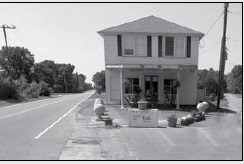
The location is Wolf Creek Cherokee Tribal Center and Museum, 7400 Osborne Turnpike, Richmond, VA 23231.
Annette Price, Coordinator of the Wolf Creek Cherokee Tribal Center and Museum, will give a guided tour of the artifact collection and regalia displays with time afterward for questions.
visitors are welcome, so bring a friend.
Driving directions: From the intersection of Main Street downtown and Route 5, take Route 5 east for 2.6 miles to where Osborne Turnpike forks to the right (There's a 7-Eleven there). Go 2 miles on Osborne Turnpike to the Wolf Creek Cherokee Museum.
>Back to Top<
Friends of Meadow Farm Replace Lost Livestock
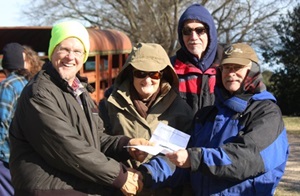
Thanks to the Friends of Meadow Farm, there are new livestock arrivals. Mike, a mule, and Coontail, a cow, had recently passed away; while Hammy, the remaining mule, had been returned to his previous owner. Now, John and Henry have taken up residence at Meadow Farm, and Bossy the cow has moved in as well. The photo at the top shows the owner of the cow from Full Quiver Farm LLC, Terry and Ken Murphy, donors of Bossy and Rim Gardner, a Meadow Farm Employee. At the left, is Meadow Farm's assistant site manager Linda Eikmeier and Henry. Tinky Keen is seen above with John. And there is soon to be a new arrival — Bossy is expecting a calf in June. Photos by Gary Boyd.
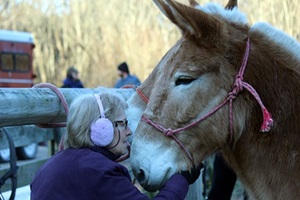
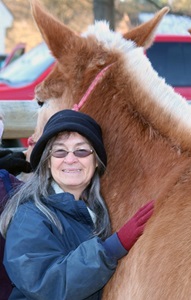
>Back to Top<
Uncoupling Trains & Encouraging Couples: The Inventive William O. George
We are creatures of a dual nature. Every realist harbors a streak of romanticism, while even the most practical of us will experience periods of whimsy. William Orville George, a mid-nineteenth century resident of Henrico, and his inventions demonstrate thisduality quite well.
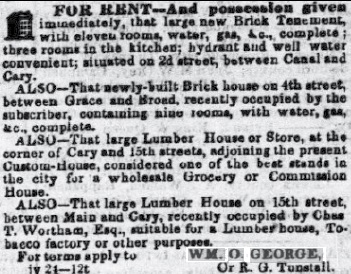
According to the Library of Virginia, the George family were prominent residents of Caroline, Henrico, and Middlesex Counties, and the City of Richmond, Virginia. The son of Byrd George of Henrico and Catherine Wilson of Caroline County, William Orville George was born on 28 February 1811. He was a gentleman who earned his living through real estate, owning a number of buildings in Richmond which he rented.
William O. George real estate. This advertisement appeared in the 24 July 1856 edition of the Daily Dispatch in Richmond.
He was an officer in the Richmond Light Dragoons, and he was active in politics. The Richmond Enquirer of 6 February 1840 lists him with six other men elected to a committee to formulate resolutions for the Democratic Republican party's convention in Richmond.
He was a practical man of business, military and politics. But William O. George was more than a landlord, militia man and political activist. His suit or uniform also clothed an inventor, an owner of patents; and those patents issued to him for his inventions illustrate both the practical man and the romantic.
First, let us look at the practical inventor, the man who devised an improved method for uncoupling railroad cars.
It seems that when rail cars jumped the track, they often failed to uncouple, thereby increasing the danger and damage of the accident. George had a solution. He received U.S. Patent 15,839 for on 7 October 1856 for "Bumper Arrangement in Uncoupling Rail-Cars." The patent explains the need he saw: "In many if not all cases of railroad accidents, which have resulted in the loss of so many valuable lives, and destruction of property to an enormous amount, it is a well ascertained fact that if suitable means for detaching one car from another when in rapid motion had been provided, the catastrophe would have been to a considerable extent prevented."
To address this problem, his solution was "arranging and supporting a rod under and running lengthwise of each car, . . . [It] shall when operated strike against the forward end of the rod in the succeeding car, causing it to withdraw the bolt that connects the cars together. By this means the engineer may in the event of danger uncouple every car in the train from each other, thus presenting a chance to some if not to all the cars to pass along the road uninjured should the engine happen to be thrown from the track."
Here was the practical man at work. But that same improver of industrial design also unleashed his creativity to improve the chances kindling romance between young gentlemen and ladies through his Oracular Wheel or Unique Centre Table.
On 13 December 1855, he addressed a ten-and-one-half page letter to the Commissioner of Patents applying for a patent on the game and table on which it was to be played. He named his game Equality, "so called in consequence of placing Man and Woman upon equal footing in an important respect."
Before explaining the workings of the game and the construction of the table, he wrote: "There are in this world numbers of the male sex so very nervous, bashful and backward as not to be able to declare their affection for a young lady, no matter how deeply they may be attached to her. Notwithstanding the lady may possibly be both willing and ready to jump into the gentleman's arms at the slightest declaration of affection; still his diffidence or her modesty can and often does prevent its accomplishment; thus destroying the fond hopes and happiness of two beings perhaps exactly suited to each other. To obviate this difficulty and make the road to matrimony easy and certain is the principal object of this invention. For no matter how diffident the gentleman may be, nor how coy the lady, if they once play at this table, and play with earnest desire to catch each other, their object will certainly be accomplished, and that with secresy [sic], safety and dispatch."
The improver of train safety was now attempting to improve the "love train," and the patent office was going to help. However, the patent office did not immediately get on board.
Responding to George's proposal, the office responded: "the specification and one drawing of your Oracular Wheel are herewith returned for amendment. It is suggested that you prepare a new specification, instead of making amendments to the original. In that case the original is to be also returned to this office. Irrelevant matter is to be rejected, and the specification would be in better form if the two first paragraphs on p. 3 of the accompanying circular were made to begin your specification, and following them with the paragraph marked with an asterisk on the 2nd p. of your original specification."
So the romantic William George recognized the reality of the situation, removed the page and a half of material lauding the romantic possibilities of his Oracular Wheel, resubmitted the proposal and was granted U.S. Patent No. 14,910 on 20 May 1858.
The original patent documents issued are both found in the George Family Papers 1733-1920 housed in the Library of Virginia manuscript collection. As do William George's two inventions, these two documents also seem to offer a nod to our dual nature.
A government document conjures images of dry prose and business-like efficiency — no frills. But these government documents are things of beauty. They are large, heavy 19.5" x 13.5" sheets with a pink ribbon binding it to the submitted drawings and explanations. They feature a steel engraved image at the top and an embossed seal at the bottom.
Unfortunately, it seems that neither of his inventions was ever produced nor were the rights to the patents ever purchased; and William O. George, hopeful railroad improver and assistant to Cupid, died in Richmond on 16 August 1869.
Joey Boehling
Source: George Family, Papers, 1733-1920, Accession 24642, City of Richmond Circuit Court Records, Local government records collection, The Library of Virginia, Richmond, VA 23219.
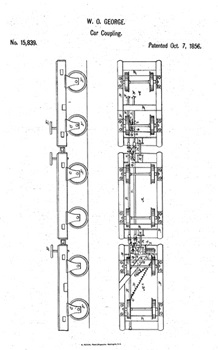
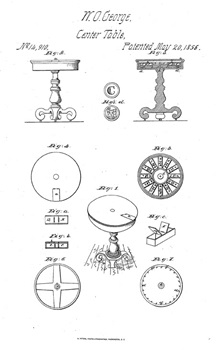
Patent Illustrations. The two drawings above and to the right illustrate the workings of William O. George's Bumper Arrangement for Uncoupling Rail-Cars and his Oracular Wheel.
>Back to Top<
The Path of True Love Requires Great Patience, Especially if the Couple Plans on Playing Equality
William O. George's game of Equality required what he called the Oracular Wheel or Unique Centre Table, a table with a removable rotating top. The top had a hinged door in the top, and when it was opened it revealed one of any number of boxes placed inside the table. Those boxes contained "checks," which were cards, tiles or some sort of marked object. While its intended purpose was to encourage potential love matches, the participants had first to master the instructions printed here as they appear in George's patent. It is possible that the complexity of the instructions could have been as big a hindrance to sparking a romance as the man's shyness or the lady's modesty — the traits George identified as the biggest obstacles.
The table is placed in a room where there is a company of unmarried persons of both sexes. Suppose by way of illustration that a game with this table is proposed to be played, and assented to by the company. Some one then arranges the checks in the front part or apartment of the boxes so that they are positive that all those in a box are of the same kind, that is to say have the same letter or marks on them, and there should be as many checks put in each box the neutral excepted as there are persons playing, and it depends upon the number of boxes in the wheel as to how many persons can play at a time. The person who places the checks then retires from the room until the game is over. A sheet of writing paper is now placed upon the table, upon which are written the names of the ladies and gentlemen that wish to engage in the play; opposite to each name is written the number of a box, thus assigning one box to each player. The game now commences. The first on the list goes to the table; and if a gentleman looks on the paper and finds his own name opposite to which he sees the number of his box, he now turns the wheel until he comes to his box, raises the lid and takes out a check from the front apartment; he then looks on the paper again and finds his lady love's name, opposite to which he sees the number of her box, then he slips his check in the rear apartment, and takes out one from the front, which he holds concealed in his hand, taking care to turn the wheel before he leaves the table, to prevent discovery. Thus each player does until all have played. The top of the table is then raised or lifted off, then each one takes out his or her own box and examines the contents of the rear apartment. If a gentleman, and he finds there a check corresponding with the one held in his hand, he will at once know that it must have been placed there by his lady love (meaning the lady he played to catch) and no one else, as no one else has a similar check in their box, while the lady if she played to catch the same gentleman, at the same moment discovers that the one in the rear apartment of her box corresponds with the one taken from her lover's. Thus it follows as a matter of course, or is at any rate presumable, that they must be mutually pleased, as they played to catch each other. But if the gentleman finds in the rear apartment of his box a check not corresponding with the one held in his hand, he of course cannot tell from whence it came, nor who placed it there, as he has only had the privilege of going into one box besides his own, and of course knows not the contents of the other boxes; all he knows is that the person he played to catch did not play to catch him. If a lady finds in the rear apartment of her box a check different from the one taken from the gentleman's, she will know at once that it was not placed there by him, as he has no such check but cannot tell him whence it came; all she knows is that he did not play to catch her, and consequently did not wish to catch her. The game may be shortened by someone's taking a check from the front apartment of each player's box without looking at it, and handing the check to the owner of the box before the game commences. It will save the necessity of each player going into his or her own box, as they will thus know the contents and have one of the checks to play with. Those persons not disposed to play to catch any one, can play into the neutral box. The checks should always be thrown into a pile so soon as the game is over. In playing, each player takes care that no one discovers whose name on the list his eyes are fixed on, or whose box is entered, but enough of the players actions should be seen to prevent going into more than one box besides his or her own. The attempt to use the checks of another instead of one's own would only produce confusion without gaining information.
>Back to Top<
Lenten Tradition of Tansy
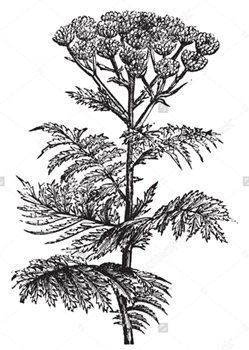
Lent is here, and a forgotten culinary tradition of the season is tansy, an herb people used to flavor dishes when they celebrated the end of Lent. The herb is bitter and had been used historically to treat kidney ailments and to rid the body of intestinal parasites. As Susan Wittig Albert notes in abouthyme.org "Some writers suggest that the tradition [of using tansy at the end of Lent] began with the bitter herbs that were used to celebrate the Jewish Passover, adapted to Christian use. Other writers suggest that tansy was used as a blood cleanser after the rigors of Lenten fasting."
At any rate, Mary Randolph offered the following recipe for tansy pudding in The Virginia Housewife:
Beat seven eggs very light, mix with them a pint of cream, and nearly as much spinach juice, with a little juice of tansey; add a quarter of a pound of powdered crackers or pounded rice made fine, a glass of wine, some grated nutmeg and sugar; stir it over the fire to thicken, pour it into a paste and bake it, or fry it like an omelette.
>Back to Top<
John N. Powell's Farm Production Before & After the Civil War
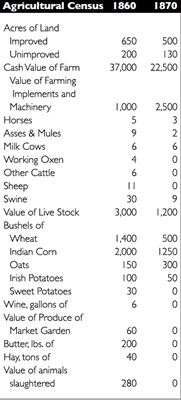
Our last issue of the Henrico County Historical Society Newsletter explored the plantation journal kept by Mary C. Powell, wife of John Norment Powell, who owned Melrose, a sizeable farm northwest of Richmond in Henrico County near Yellow Tavern. The journal contained a variety of entries recorded over the period between May 1858 and May 1870.
Powell's name and holdings show up in the United States Census Agricultural Schedules of both 1860 and 1870 (he is absent from the 1880 record), and those records offer an interesting picture of the change in Melrose affairs likely brought on by the Civil War.
In both censuses, Powell's holdings, while not the largest, are among the larger entries in the area. However, in nearly every category, Melrose declined over that ten year period. That much is obvious from the two entries pictured below. The 1860 census shows 650 improved acres, 200 unimproved acres, a total farm value of $37,000 and $1,000 worth of farm implements and machinery; the 1870 census records entries of 500, 130, $22,500 and $2,500, respectively.
It should also be noted that the 1870 illustration has an extra column not present in the 1860 document. It is an entry indicating that $1,200 had been paid in wages, including board. The abolition of slavery apparently required the hiring farm labor.
And it may have also account for the growth in the value of farm equipment. The farm was smaller in 1870, but the value of the implements and machinery had grown.
The accompanying chart compares the output of Melrose in 1860 and 1870 and shows a decline in each product (and disappearance of several) with the exception of a growth in oat production.


>Back to Top<
Twas a Tangled Web We Wove
We express our thanks to Judith Towers and her friends in the Richmond Weavers Guild for their help in explaining the meaning of the entry in Mary Powell's journal that appeared in our last issue. The note pasted into the journal refers to weaving and setting up a loom. Here is the transcription of the note:
25 bear is allowed to a 500 slaie
20 bear is allowed to a 400 slaie
40 threads of warp to a bear
To the harness which you brought there are only 30 bear containing from 9 to 13 eyes. The harness shoudl contain to each sheet 500 eyes to hold the warp which is warped to 25 bear, which makes 1000 thread of the warp at 40 threads of warp to a bear;
50 bear to an 800 slaie
In a loom, the long threads are called the warp, and the horizontal threads that are drawn through the warp to create the design in the fabric are called the weft (sometimes called the woof). In setting up the loop the slaie (slay or sley) is the warp count of the woven fabric, and bear (or beer) is a group of yarns which make up a section of the warp. Harness is an older term for shaft, the frame that holds the heddles. Each thread passes through the ey of one heddle. There are at least two shafts or harnesses on a loom; more often there are 4 harnesses; occasionally 8 harnesses, and even more. Each shaft is connected to one treadle (pedal) or more, and lifts up (or in some cases lowers) a whole row of heddles, lifting a group of threads so that the shuttle can pass between the layers in front of the reed. Then the reed, positioned in the beater, is brought forward to press that row of weft thread next to the previous woven row at the front of the loom.
A reed is part of a loom that resembles a comb and is used to push the weft yarn securely into place as it is woven. To "sley the reed" means drawing the threads through spaces, also called dents, in the reed.
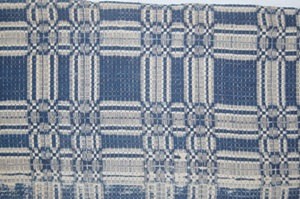
Homespun coverlet This is an overshot coverlet like one that would have been woven on Mary c. Powell's loom. Weaving an overshot coverlet required two shuttles, where one shuttle of weft wove a plain weave fabbric while the second shuttle carred a heavier weft which floated over areas of warp to create what is known as "pattern." This heavier weft also floated under areas of warp for what is called "background". These were generally woven in two long pieces which were then joined to achieve the desired width of the coverlet.
>Back to Top<
What Do You Know?
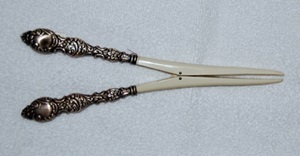
The object pictured here is 8 1/2" long. The handles are sterling silver, and the white parts are ivory.
Email your answers to:
jboehling@verizon.net
>Back to Top<
News 2016: First Quarter
Second Quarter | Third Quarter | Fourth Quarter
Home | Henrico | Maps | Genealogy | Preservation | Membership | Shopping | HCHS
|











